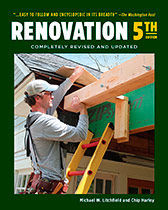Podcast 299: Attic Ductwork, Twice Double-Hipped Roofs, and Keeping Warm in Calgary
Rob, Kiley, and Patrick hear from listeners about Jeff’s Blue Dog print and monitoring indoor-air quality before taking questions about where to put the ductwork, what is this roof, and making a comfortable space for gatherings during COVID-19.
Follow the Fine Homebuilding Podcast on your favorite app. Subscribe now and don’t miss an episode:
 |
 |
Help us make better episodes and enter for a chance to win an FHB Podcast T-shirt:
www.finehomebuilding.com/podcastsurvey
Barbara (not that Barbara) asks where Jeff’s Blue Dog print is. Tom offers his take on curbless showers. Jonathon describes his method of PT disposal. Kathryn shares her insights on indoor-air-quality monitoring. Jessica asks for advice on changing careers. Katie asks what kind of roof she has. Ben seeks a solution to staying warm during outdoor family gatherings. Kyle asks how to keep his entryway more comfortable.
Editor Updates:
- Rob’s kitchen remodel
- Kiley’s outdoor work, air filter
- Jeff’s window trim, outdoor work
- Patrick’s washer/dryer/kitchen remodel
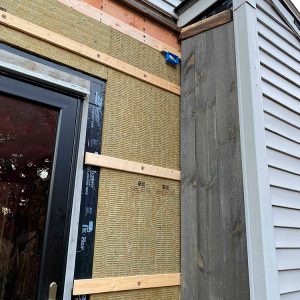 |
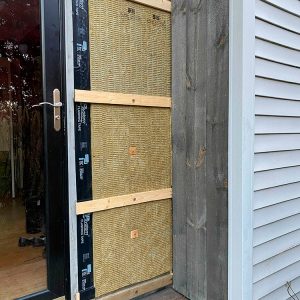 |
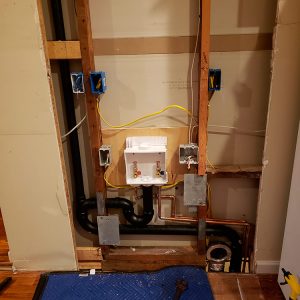 |
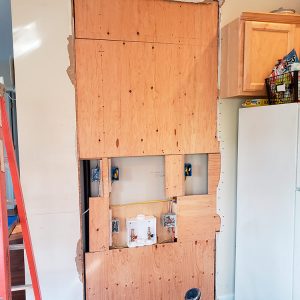 |
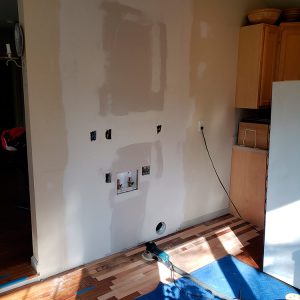 |
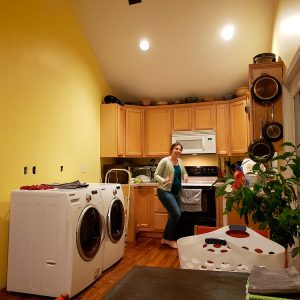 |
Listener Feedback 1:
Barbara (not that one, but I’m interesting too.) writes: Dear Jeff, For a long time I’ve really enjoyed seeing your Blue Dog art print hanging on the wall behind you. I’m a huge fan of Blue Dog prints, and have one of my own. Suddenly, your Blue Dog print has been replaced by something completely mundane and uninteresting.
BRING BACK BLUE DOG!!!!
Pretty please?
 |
 |
Listener Feedback 2:
Tom writes: Hi FHB Podcasters, I was listening to your podcast as I was air sealing and insulating the rim joist on my house. Thanks for providing the me the impetus to do this, I guess – the fiberglass batt insulation that was stuffed in there holds an amazing amount of mouse poop along with the occasional desiccated body. On podcast 285, you were answering someone’s question about how to seal a tub in a wet room with a curbless shower. Patrick just said “just do a curb already” or something like that. Rob chimed in that, based on the frequency he cleans hair out of his standard shower drain, it seemed likely to flood. I have a curbless shower that I build based on Jake Bruton’s article in FHB (issue 255). He said: “build up, not down”, and put the drain at the shower entrance. Well, FHB doesn’t often steer me wrong, but boy do I regret building this shower. It looks very cool, but you have to pay close attention to how often the drain is cleaned out. If you don’t, you will be stopping mid shower to squeegee the water back to the drain and cleaning out the hair . If your listeners are thinking about a curbless shower, build down, not up! And put the drain at the back so you at least have some warning when the drain is clogged. Keep up the good work, and a sharper eye on those yahoo’s that put together the print magazine.
Related Links:
Listener Feedback 3:
Jonathon writes: Greetings. I finally paid a laborer to bring a boatload of PT lumber debris from my backyard.
I pursued several options for disposal:
1) renting a pickup and trailer to haul it to the transfer station
2) buying Bagsters from Waste Management or
3) slowly disposing of it in the weekly trash.
Each option was too expensive, time consuming or inconsiderate to my neighbors.
I realized with the PT shortage people would come pick it up for free. Rotten PT lumber with rusty spikes didn’t deter people. I posted it on Craigslist and Facebook and immediately got responses. Most people planned to use it for raised planter beds. It’s amazing how desperate people were for PT lumber! They couldn’t get enough of it.
Three cheers for recycling!
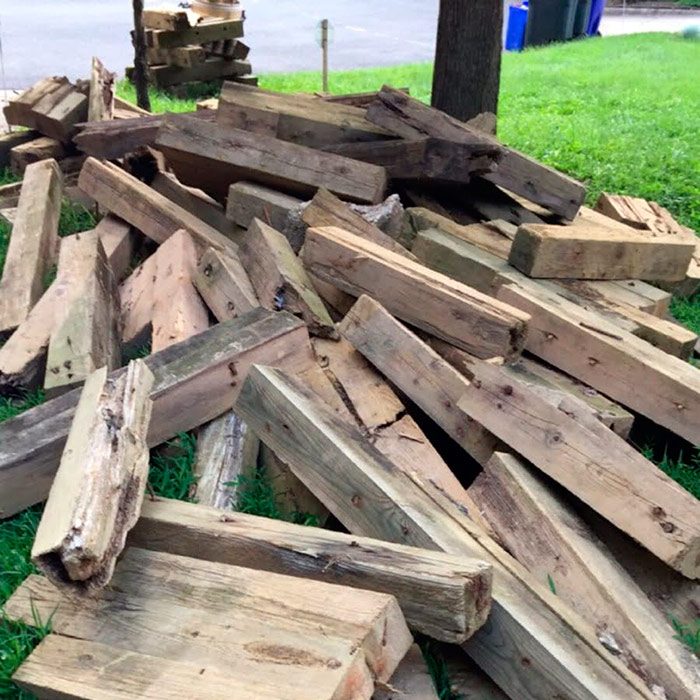 |
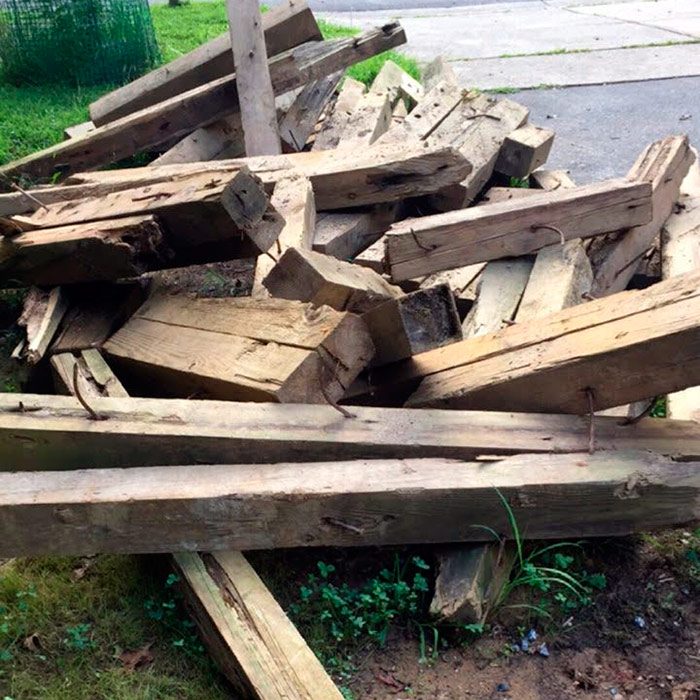 |
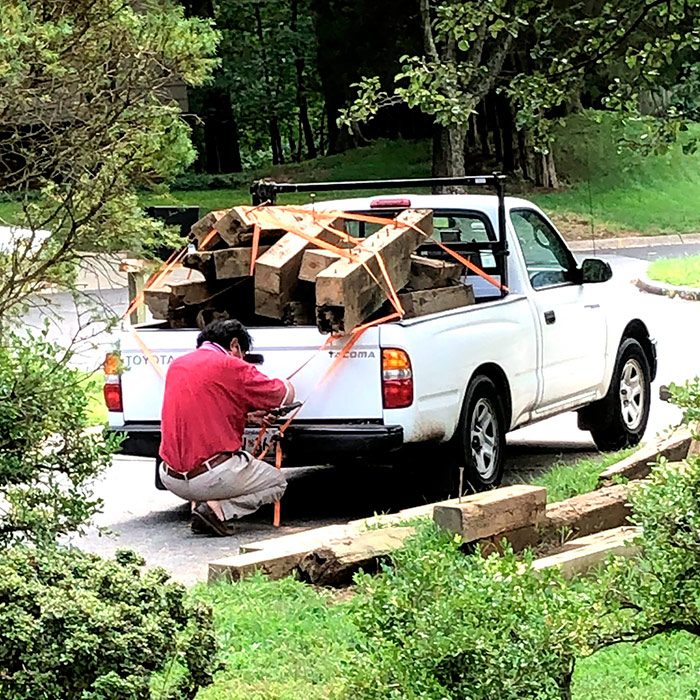 |
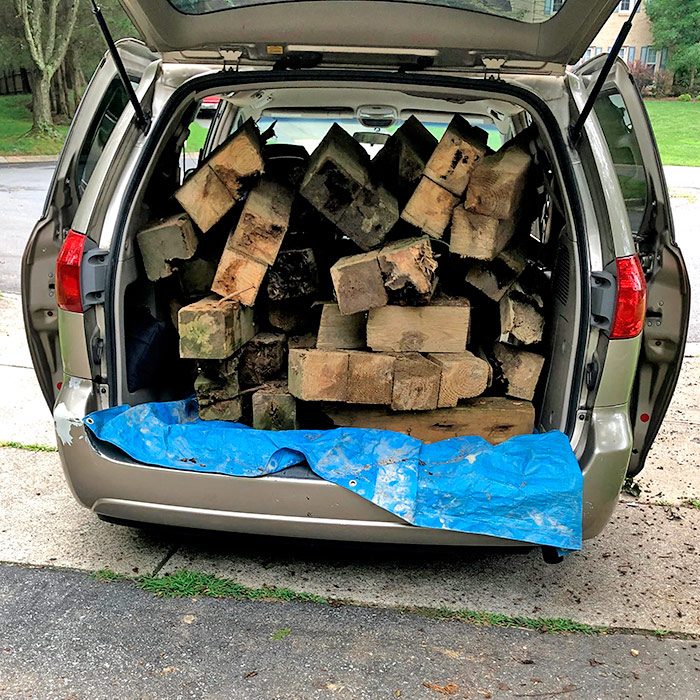 |
Listener Feedback 4:
Kathryn in Seattle writes: Dear FHB Podcast, I listened with interest to your conversation about indoor air quality. When it comes to sensors, there are quite a few, but I certainly agree that there’s a lot of room for improvement in the consumer market. The Flow 2, by Plume Labs is a portable sensor that gives you PM1, PM2.5, PM10, NO2 and VOCs, which is a nice range of pollutants. PM2.5 is usually the one that people are most concerned with because it’s associated with traffic emissions and wildfire smoke. In my home use, I was always amused to find that the particulate levels spiked hugely the moment we started to fry something, which is one reason why kitchen range hoods are so important. Even better was when it noticed that we were drinking alcohol and the VOCs would spike. Kylie may notice more while oil painting. At ~200$, this is not an incredibly cheap sensor, but since it’s portable, it can be shared, so that’s nice. I’d love to have one of these to check out from the library.
Another sensor that’s very popular is the Purple Air. It’s a permanently mounted Particulate sensor, that uses the data to make global maps of PM2.5 pollution. They also have redundant sensors to ensure repeatability and longevity. During the recent California wildfires, you could watch the smoke plume shift across the country on this map. They also have an indoor version, so you can see how well your filter is doing. This sensor is about the same cost as the Flow at 250$.
If you’re a little more handy with coding, you can get something like the standalone PM2.5 sensor from Adafruit which is 40$, but you have to connect it to a Raspberri Pi or Arduino and write code for it. Then you can attach a 100$ CO2 sensor to make sure that all of your filtration and air sealing hasn’t compromised your CO2 levels and add a 20$ VOC sensor just for fun.
None of these are going to be as accurate as very expensive sensors, but they do tell you useful things like how bad the air is in your house and where the smoke is leaking in from. In my case, it was down the *&^% chimney, which is now permanently foamed shut.
I confess that when the wildfire smoke was terrible, I was really happy that I had a HEPA HRV and I installed some activated carbon filtration to reduce the terpenes (which make your eyes sting). I comfort myself by saying that though this isn’t a cheap hobby, it’s still cheaper than hobby cars.
PS: When it comes to air exchanges in public buildings for coronavirus safety, 12 ACH is considered good to reduce transmission of respiratory pathogens (using turberulosis as a proxy). This is what is used in ER waiting rooms.
Related Links:
Question 1: What’s the best way to get ducts into conditioned space if your house is built on a slab?
Jessica writes, Hi Guys, I’m 33, live in about an hour southeast of Sacramento, CA (Manteca), and have been making a good living as a supervisor/manager for a precast manufacturer for several years now, but I find myself unsatisfied. I want to see the fruit of my labors instead of just being a desk jockey. Unfortunately, I’m coming to this realization a little later in life, and desk jockeying is where my skills and experience lie! In order to get a foundation in residential construction, I’m taking a framing and electrical class at a local community college (mostly online due to COVID–not ideal). And of course, I’m listening to your excellent podcast and subscribed to your website. This is a long shot, but I was thinking that if I can find a good contractor in my area, maybe I could negotiate a position that have them good value with my current skills yet include some time “apprenticing” with the tradesmen. I only want to learn from true craftsmen, and I don’t know how to find them. You guys seem to know top notch contractors across the US, so are there any contractors in my area you can recommend? The worst that can happen is they say no, right?
I also a really podcast question:
On the west coast, we don’t have basements. Water heaters are in the garage, and HVAC is on the roof or on the ground outside–newer homes may have it in the attic. Regardless of where the main unit is, ducting is always in the attic if the foundation is slab on grade. The attics are all vented, though, which sounds like the safest route from the podcast. How do you “bring the mechanicals into the conditioned envelope” under these circumstances? Put the HVAC in the garage and insulate the garage? The ducting still has to go through the attic, so then you just air seal and wrap as much insulation as you can around them?
Love you guys!
Related links:
Question 2: What would you call this style of roof?
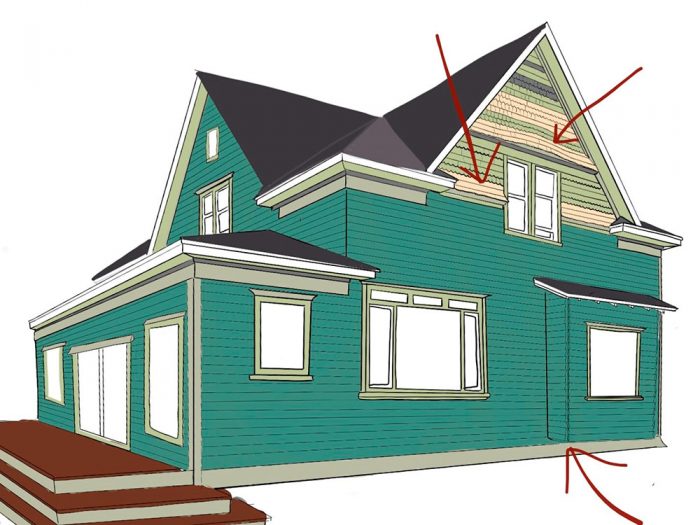
Anyway, there are a couple architectural features that I’ve never seen before – I’ve been researching/asking every one in my world and no one knows the answer: so I’m turning to your expertise and network ?.
1. What style is our roof? It’s double hipped, twice. Is this common anywhere? The hips all met in the center around the chimney. It’s awesome because the upstairs is huge, but it was also a terrible roof to cut our teeth on when we re-did it this summer. 8 hips. 8 valleys. So much flashing at the center. I’ve seen this on double hipped houses – just never going all the way back to the center.
2. The exterior has decorative dip edge kick outs – eyebrow things above the gable windows, another sawtooth drip edge below the gable windows, and a foundation skirt (the only style I’ve been able to find any information on). What are these features called? My internet searches have failed. (Below I have listed search terms that yielded no results for your amusement)
Thanks for all you do and grounding us through this crazy year! Thank you!!
Related Links:
Question 3: How can my family keep warm at outdoor gatherings?
Ben in Ohio writes, Dear FHB: With the recent pandemic, our family faces the challenge of maintaining contact while still maintaining distance. My parents are both in the high risk categories and while I have reduced my trade work and remain inside their sphere of people, my sister runs another business and is outside our sphere.
My mother came up with the great idea of family lunches on Sundays on the country porch. This has worked very well until when a Sunday dropped below 50 degrees. While it was a great chance to experience my new Milwaukee heated the jacket, the remainder of the family appeared to be less enthused.
What creative recommendations do you have for those of us in the north headed into winter who want to meet outside with the family? How do we keep everyone comfortable while maintaining the distance.
[Our present solution is a series of tarps boxing in the upper half of the porch (there is a gap at the top and it allows airflow) with a diesel fueled radiant heater from Summit Racing warming up the air and aimed at my sister who sacrificially sits at the porch opening being blasted by the 70,000 BTU breath of a dragon. We tried to find a patio heater with no success. This seemed like a fun brainstorming question for you all and thought you all might have some zany and some serious solutions. I find New Englanders are much better at winter survival than us mid-west folk].
Related Links:
Question 4: How can I make my split-level house warmer and less drafty?
Kyle in Calgary, Alberta, Canada writes, Hello from snowy Calgary, it’s currently -4C in October!
I recently renovated a 1600 sq ft 60’s bilevel house. To paint a picture, the landing at the front door is 7 steps down to the basement, 7 up to the mainfloor. When you arrive at the main floor, the living room is directly adjacent to the front door landing although grade separated with a railing. I kept the existing duct system largely intact but in locations I changed the heat registers and returns to new locations along with a new gas furnace. 2 years later I have found one issue which is likely a function of the house design/heating system choice.
The main issue is that the front door/sidelite is always a cold spot traditionally in any house. On top of this, the heat register at the landing barely blows since it’s the furthest away from furnace and there is a double elbow coming down from the basement ceiling to get it to the mid-landing. The living room is directly adjacent to this area and feels a little drafty (especially on days when it’s marginally cold so the furnace isn’t coming on frequently).
I was looking into a little wall mounted convection blower/heater to condition this space a little better. Any thoughts?
If you have time…. second minor issue is my kitchen sink pot light. I have an early version of a prefab truss system where there is no heel so the top chord attaches directly to the horizontal chord at ceiling. I ended up spray foaming the first 2-3 feet around the perimeter as there is barely any insulation at these spots…. The pot light at my kitchen is one of those flush mount/finger snapper models. In order to get the fixture in place I had to slightly shave some spray foam out of the way. I noticed last winter I am getting a faint yellow blotch here which I assume means it’s condensing at the weak thermal spot. Anyhoo… wondering if I should at least try to paint on a liquid vapour barrier to try and stop the moisture coming through at this location.
Great show, keep up the good work.
Related Links:
Visit the Taunton Store • Magazine Index • Online Archive • Our First Issues • All Access
Help us make better episodes and enter for a chance to win an FHB Podcast T-shirt: www.finehomebuilding.com/podcastsurvey
If you have any questions you would like us to dig into for a future show, shoot an email our way: [email protected].
If we use your question we’ll send you a FHB Podcast sticker!
FHB Podcast T-shirts!
Represent your favorite podcast! Available in several styles and colors. Made from 100% cotton. Find the Podcast t-shirt and more cool products in the Fine Homebuilding Store.
This episode of the Fine Homebuilding podcast is brought to you by BuildBook.
Happy Clients. More Profits. Less Stress. That’s the trifecta of the construction business. We all want that, right? Well, after working and talking with 100’s of home builders and remodelers over the past 2 years, BuildBook has discovered the one common ingredient that determines the success of your construction business…the client experience.
Yes, if you drop the ball anywhere in the client experience from the first impression to the final payment, things can get super messy super quickly.
BuildBook has spent the past several months developing the first-of-its-kind platform that focuses on helping you deliver throughout the client journey the one thing standing between you and achieving the trifecta of construction.
It starts with marketing tools to attract the right leads. Add in sales tools so you can win the best projects. And finish with project tools that knock your clients socks off!
If you’re looking for an unfair advantage in your business, this is it. Head on over to BuildBook.co now to try it free for yourself.
Visit BuildBook.co for more.
Fine Homebuilding podcast listeners can get 20% off anything in the Taunton store, including the Renovation, 5th Edition.
Use the discount code FHBPODCAST to take advantage of this special offer.
We hope you will take advantage of a great offer for our podcast listeners: A special 20% off the discounted rate to subscribe to the Fine Homebuilding print magazine. That link goes to finehomebuilding.com/podoffer.
The show is driven by our listeners, so please subscribe and rate us on iTunes or Google Play, and if you have any questions you would like us to dig into for a future show, shoot an email our way: [email protected]. Also, be sure to follow Fine Homebuilding on Instagram, and “like” us on Facebook. Note that you can watch the show above, or on YouTube at the Fine Homebuilding YouTube Channel.
The Fine Homebuilding Podcast embodies Fine Homebuilding magazine’s commitment to the preservation of craftsmanship and the advancement of home performance in residential construction. The show is an informal but vigorous conversation about the techniques and principles that allow listeners to master their design and building challenges.
Other related links
-
- All FHB podcast show notes: FineHomebuilding.com/podcast.
- #KeepCraftAlive T-shirts and hats support scholarships for building trades students. So order some gear at KeepCraftAlive.org.
- The direct link to the online store is here.





